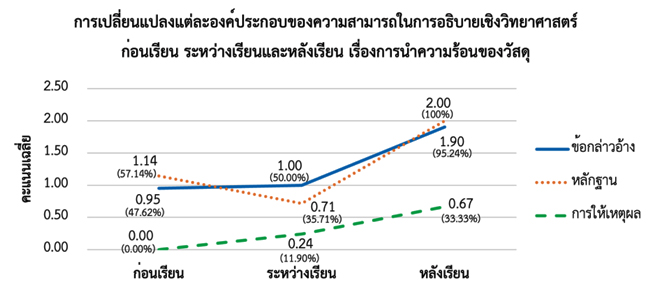การส่งเสริมความสามารถในการอธิบายเชิงวิทยาศาสตร์ เรื่อง วัสดุในชีวิตประจำวัน ของนักเรียนชั้นประถมศึกษาปีที่ 4 ที่เรียนรู้โดยใช้บริบทเป็นฐาน
Main Article Content
Abstract
Jirawat Kumprom, Duangsmorn Kitkosol and Pattawan Narjaikaew
รับบทความ: 28 ตุลาคม 2568; แก้ไขบทความ: 19 มกราคม 2568; ยอมรับตีพิมพ์: 25 มกราคม 2568; ตีพิมพ์ออนไลน์: 22 มิถุนายน 2568
บทคัดย่อ
การวิจัยในครั้งนี้มีวัตถุประสงค์เพื่อศึกษาและเปรียบเทียบความสามารถในการอธิบายเชิงวิทยาศาสตร์ เรื่อง วัสดุในชีวิตประจำวัน ของนักเรียนชั้นประถมศึกษาปีที่ 4 ก่อนและหลังการจัดการเรียนรู้โดยใช้บริบทเป็นฐาน ตัวอย่างของงานวิจัยนี้เป็นนักเรียนชั้นประถมศึกษาปีที่ 4 โรงเรียนประถมศึกษาขนาดกลางแห่งหนึ่ง สังกัดสำนักงานเขตพื้นที่การศึกษาประถมศึกษาสกลนครเขต 3 ภาคเรียนที่ 1 ประจำปีการศึกษา 2567 จำนวน 21 คน ที่ได้มาจากการสุ่มแบบกลุ่ม การวิจัยครั้งนี้มีแบบแผนการทดลองแบบกลุ่มเดียวทดสอบก่อนเรียนและหลังเรียน เครื่องมือที่ใช้ในการวิจัยครั้งนี้ ประกอบด้วยแผนการจัดการเรียนรู้โดยใช้บริบทเป็นฐานเรื่องวัสดุในชีวิตประจำวัน จำนวน 4 แผน และแบบทดสอบความสามรถในการอธิบายเชิงวิทยาศาสตร์ จำนวน 5 สถานการณ์ โดยแต่ละสถานการณ์ประกอบด้วย 3 คำถามย่อย คือ ข้อกล่าวอ้าง หลักฐาน และการให้เหตุผล วิเคราะห์ข้อมูลทางสถิติโดยใช้ความถี่ ค่าเฉลี่ย ร้อยละ ส่วนเบี่ยงเบนมาตรฐาน และการทดสอบทีแบบไม่อิสระ ผลการวิจัยพบว่า นักเรียนชั้นประถมศึกษาปีที่ 4 ที่ได้รับการจัดการเรียนรู้โดยใช้บริบทเป็นฐานมีความสามารถในการอธิบายเชิงวิทยาศาสตร์หลังเรียน (ค่าเฉลี่ย = 21.76 คิดเป็นร้อยละ 72.54) สูงกว่าก่อนเรียน (ค่าเฉลี่ย = 6.29 คิดเป็นร้อยละ 20.92) และมีแนวโน้มการเปลี่ยนแปลงทั้ง 3 องค์ประกอบของความสามารถในการอธิบายเชิงวิทยาศาสตร์อยู่ในระดับที่สูงขึ้น
คำสำคัญ: การจัดการเรียนรู้โดยใช้บริบทเป็นฐาน การอธิบายเชิงวิทยาศาสตร์ วัสดุในชีวิตประจำวัน สมบัติของวัสดุ
Abstract
This research aimed to study and compare students’ scientific explanation ability on properties of material in daily life before and after learning through context–based learning. The sample consisted of 21 grade 4 students who studied in the first semester of academic year 2024 in a medium–sized primary school under Sakon Nakhon Primary Educational Area Office 3, using cluster random sampling technique. The one–group pretest–posttest design was employed in this study. The research instruments consisted of 4 lesson plans based on materials in daily life and 5 testing situation, which each of these situations was followed by three types of questions: a claim, evidence, and reasoning. The collected data were statistically and analyzed for mean, standard deviation, percentage and frequency. T–test for dependent samples was used in hypothesis testing. The research results found that the students had scientific explanation ability after learning higher than those before learning. The average scores of the pretest and posttest were 6.29 (20.92 percent) and 21.76 (72.54 percent), respectively. In addition, students had higher scientific explanation ability in all three components after learning.
Keywords: Context–based learning, Scientific explanation, Materials in daily life, Properties of material
Downloads
Article Details

This work is licensed under a Creative Commons Attribution-NonCommercial 4.0 International License.
References
Dori, Y. J., Avargil, S., Kohen, Z., and Saar, L. (2018). Context–based learning and metacognitive prompts for enhancing scientific text comprehension. International Journal of Science Education 40(10): 1198–1220.
Gilbert, J. K. (2006). On the nature of “context” in chemical education. International Journal of Science Education 28(9): 957–976.
Jaitip, C., and Chienwattanasook, K. (2018). The capacity of business leaders in a global situation characterized by volatility, uncertainty, complexity and ambiguity. Burapha Journal of Business Management 7(1): 1–14. (in Thai)
Khotabin, S., and Narjaikaew, P. (2024). Grade 12 students’ scientific explanation competency on celestial sphere and astronomical phenomena through model–based learning. Journal of Research Unit on Science, Technology and Environment for Learning, 15(1): 114–132. (in Thai)
Lertdechapat, K., and Promratana, P. L. (2018). Effect of collaborative inquiry on ability in the scientific explanation making of lower secondary school students. Journal of Education Studies 46(2): 1–20. (in Thai)
MacMahon, S. J., Carroll, A., Osika, A., and Howell, A. (2022). Learning how to learn—implementing self–regulated learning evidence into practice in higher education: Illustrations from diverse disciplines. Review of Education 10(1): e3339.
McCarthy, M. (2016). Experiential learning theory: From theory to practice. Journal of Business & Economics Research 14(3): 91–100.
McNeill, K. L., and Krajcik, J. (2011). Sup-porting Grade 5–8 Students in Constructing Explanations in Science: The Claim, Evidence and Reasoning Framework for Talk and Writing. New York: Pearson Allyn & Bacon.
Ra–Ngubtook, W. (2020). Thai learners’ key competencies in a VUCA world. Journal of Teacher Professional Development 1(1): 8–18. (in Thai)
Sariwat, L. (2014). Psychology for Teachers. Bangkok: Odeon Store. (in Thai)
Sriphrom, P., and Onthanee, A. (2020). Development of learning activities by using context–based learning with infographics to enhance scientific literacy and attitude toward science on the topic of chemical bonds for grade 10 students. Journal of Education Naresuan University 23(3): 159–174. (in Thai)
Srisakuna, S. (2022). Developing grade 10 students’ scientific explanation in the topic of motions by using context–based learning. Journal of Research Unit on Science, Technology and Environment for Learning 13(1): 29–41. (in Thai)
The Institute for the Promotion of Teaching Science and Technology [IPST]. (2022). PISA Thailand: Assessing Science Framework. Retrieved from https://pisa thailand.ipst.ac.th/about-pisa/science_com petency_framewark, December 6, 2022. (in Thai)
Tuntirojanawong, S. (2017). A direction of educational management in the 21st century. Veridian E–Journal Silpakorn University 10(2): 2843–2854. (in Thai)
Vaino, K., Holbrook, J., and Rannikmäe, M. (2012). Stimulating students’ intrinsic motivation for learning chemistry through the use of context–based learning modules. Chemistry Education Research and Practice 13(4): 410–419.
Wichadee, S. (2011). New paradigm of education: Research–based learning. Journal of Management 31(3): 26–30. (in Thai)
Yu, K. C., Fan, S. C., and Lin, K. Y. (2015). Enhancing students’ problem–solving skills through context–based learning. International Journal of Science and Mathematics Education 13: 1377–1401.
